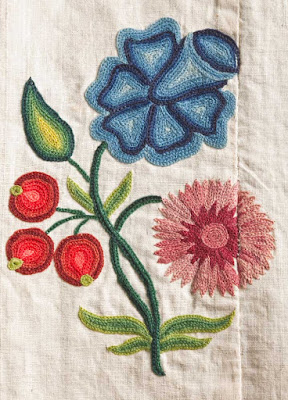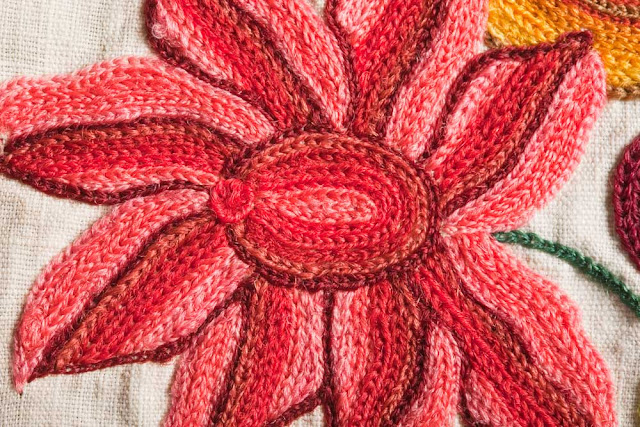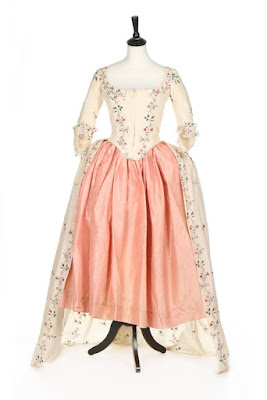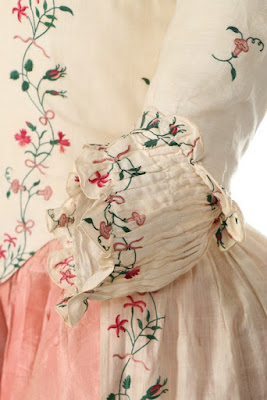...but I'm going to. Someday. Eventually.
 |
| And it's all this gown's fault. |
Because I love massive projects with finicky little details, the idea of chain stitching enough fabric for an entire robe (and all its trimmings) fills me with
delight. At first glance, I thought this 1750/60 gown from
the LACMA collection* was made of painted silk or linen—a reasonably common method of decorating fabric in the 18th century (
no, I don't know which decades, why would I look something like that up? Also, I just tried, and didn't find anything definitive in five seconds so that'll have to be explored later), but one that I can't even contemplate until I have more than .2 square feet of floor space to spread fabric out on.
This gown isn't painted, though. All the floral sprigs are chain stitched with wool on a plain-weave linen ground. Obsessive, vast in overall scale, and quite small in terms of work space needed—and with a very high entertainment-value-to-financial-investment ratio.
 |
| The red hat ribbon was a nice touch. Good job, anonymous exhibit designer! |
I also love the alternating color schemes of each type of sprig, and the careful placement of matching sprigs where the back pleats come close enough together to really mirror each other. I might lay out my trim and sleeve flounce pieces first and embroider second, though; these appear to have been embroidered and then cut to shape, and the idea of cutting into dozens of rows of embroidery just doesn't appeal to me. All those ends to anchor, for one, and then there's the matter of
cutting into a few hours' work. Looking at the seamlines of this gown, though, especially at lower left, the embroidery appears to be very carefully matched from piece to piece, not cut (or embroidered over the seam after construction), so potentially the edge pieces are treated similarly and the tiny plain edge covered with trim.
 |
| I love the shading with all the thread colors. |
I honestly have no clue what those flowers or fruits are (the red
might be a pomegranate?), but I love them. The three leaf sprigs with opposing color gradations are charming, too.
 |
| Berries! and a carnation, and a mysterious blue flower that may or may not exist. |
Again, and more clearly in this photo, the embroidery is very carefully matched from piece to piece, rather than vanishing into the seam or being mismatched with the pattern on the adjoining piece—though there's clearly a dye lot change from one side to the other of this carnation. Nice to know that was an issue for embroiderers in the past, too, and that they also responded with "fuck it, no one will notice."
 |
| Look at those nice neat rows of stitching! |
I can't
quite tell, and it's driving me crazy, but the wool is either singles or a two-ply...I lean toward singles, looking at the difference in twist on one side of the chains to the other, but that effect can happen with plied yarns, too. Either way, a vast range of shades is used throughout the gown—this flower alone has at least five distinct shades.
 |
| This one's less imposing at full length. |
Or I could do something a little less overwhelming, like this 1770-80 cotton lawn gown. I snagged the photos from
Historical Dress on Tumblr, as this was an auction item that I can't seem to find the listing for. This is a different style (obviously) and less heavily trimmed on the front.
 |
| But still charming (and so sheer!) |
The fitted back is graceful, with the nicely matched vines following the curve of the back seams. I like the little scattered sprigs in the spaces between vines, too.
 |
| Those rose buds are incredible. |
It's difficult to tell at this size, but this is chain stitch as well, though vastly more delicate and naturalistic than the other dress, even going so far as to tie the different flowering sprigs to the main vine. Again, lots of thread-color shading, even in the green leaves (at high resolution, I'm fairly certain I'm seeing a different shade for the central vein, though it could be a trick of the light).
So someday, after much more research than just drooling over these two
examples, I'll get about ten yards of plain fabric and a pile of yarn, and start stitching! Or dyeing. Probably dyeing first, since
I'm both picky and cheap, and it's only (ha!) labor-intensive to dye
white yarn in a thousand shades. And then I can say I did almost
everything myself because
I'm a glutton for punishment that would be really cool.
*Also: you can download print quality .tiff files of all the images the LACMA has online for this dress. If I wanted to, I could count the number of wool fibers in the embroidery yarn. They're
incredibly high-quality and amazing.








Comments
Post a Comment